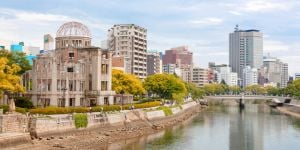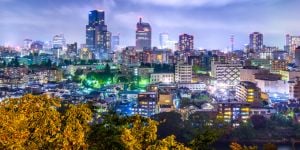
When thinking of transportation in Japan, the first things that come to our mind are punctuality, efficiency, modernity, cleanliness, and ease of access. Could the perfect transportation system be found in the Land of the Rising Sun? Here is an overview of the different means of transportation available in Japan.
Transportation in Japan
If you live in a big city, then every means of transport is at your disposal, be they bus, subway, train, etc. It's recommended that you use public transport instead of your car. Parking spaces are few and far apart, with high fees. Unsurprisingly, transportation is less diversified in small villages and outlying areas, but it is definitely there. For a better experience of your everyday life in Japan, avoid comparing everything to Tokyo, and find out about the types of transportation in your area.
Travel to Hokkaido
You will only realize how huge Hokkaido is when you decide to go on a road trip. The island alone is about the size of Austria. In town, you will find mainly trains, buses and cabs. If you want to connect with other cities at a discounted price, you should consider using buses. If you are in a hurry, opt for the Shinkansen. Sapporo, the capital of Hokkaido (the island is also a prefecture), is better served by subway, train, bus, and taxis.
Travel to Okinawa
The fastest way to travel to Okinawa is by plane. Flights from Tokyo to Okinawa take about 3 hours, and costs vary depending on departure time and options chosen. Make sure to compare between airlines to have the best deals, but the plane is not the only way to get there. You can also choose to go by train and ferry. Depending on your departure point, it might take up to a couple of days.
Once you arrive in Okinawa, you can choose between monorail, bus, or cab. You can rent a car or a bicycle. Many people say it is better to have a driver's license in Okinawa, especially if you want to go far from Naha, the capital. Opt for the ferry to move around the archipelago and reach the small islands.
Japanese countryside
It is better to have a driver's license in small countryside towns. Of course, there is always the option of a bicycle, bus, or cab. You can get to these remote towns by train, but you will find very few public transportation options to get around the countryside. Bus services are not always available in these regions as they are in medium and large cities.
Useful links:
Trains in Japan
Japan has an excellent rail network used by Japan Rail and other private rail companies that share an ultra-competitive market. With heated seats in winter, air conditioning in summer, cleanliness, and modern infrastructure, everything is done for the passengers' comfort. The Japanese train service is one of the best in the world and one of the preferred modes of transportation of Japanese people.
Train or subway?
Don't be surprised if you get confused between the train and the subway. They look very similar. The same goes for the stations. In big cities, trains and subways are intertwined. You can tell them apart by their names. Trains start with JR for "Japan Railways", and the Metro service ends with "LINE".
- Examples of train lines: the famous JR Yamanote in Tokyo or the JR Osaka Loop Line;
- Examples of subway lines: the Karasuma Line in Kyoto or the Hakozaki Line in Fukuoka.
The Shinkansen
The Shinkansen, the Japanese high-speed train, is the pride of the country. Its nine lines connect all of Japan:
- The Tokaido Shinkansen: Tokyo–Nagoya–Kyoto–Osaka;
- The Sanyo Shinkansen: Osaka–Fukuoka;
- The Kyushu Shinkansen: entire Kyushu island (North to South);
- The Hokuriku Shinkansen: Tokyo–Nagano–Kanazawa.
From March 16, 2024, the Hokuriku Shinkansen will be extended from Kanazawa to Tsuruga, leading to faster train trips in the region, especially to Fukui Prefecture (source: Japan Guide);
- The Joetsu Shinkansen: Tokyo–Niigata;
- The Tohoku Shinkansen: Tokyo–Aomori;
- The Akita Shinkansen & the Yamagata Shinkansen: two mini-Shinkansen lines branching out from the Tohoku Shinkansen;
- The Hokkaido Shinkansen: Aomori–Hokkaido.
There are, in fact, different types of Shinkansen: fast trains, which only serve the major stations; semi-fast trains, which stop at intermediate stations; and local trains, which serve all stations.
Ticket prices depend on the type of train (local, fast, limited express, etc.) and the distance traveled. Tickets can be purchased at ticket vending machines (all with English translations) or at ticket offices near the station doors. You can also buy special packages to save money or use a prepaid smart card like the Suica or Pasmo card to save time.
The Shinkansen is also a way of life. People love it for its comfort, efficiency, and its “ekiben”. The word comes from “eki” (station) and “ben” from “bento”, the lunch basket. The ekiben, or ekibento, is a lunch basket you buy at the station.
Moreover, Japanese stations compete with each other to offer the best regional dishes, all presented with utmost care. It is, therefore, impossible to find the same train meal. There would be more than 2000 different ones, as good as beautiful and affordable. Enough to turn a simple train trip into a gourmet escapade.
Useful links:
Overview of ekiben (link in Japanese)
Buses in Japan
City bus
In the big cities, you can choose between the subway, the train, and the bus. You can choose between several means of transportation for a route. Depending on the distance, taking the bus may be more advantageous. In more remote areas, the bus will become your only option, along with the bicycle and cab. Schedules are more likely to be less regular than in larger cities.
For long distances, the bus is also a good alternative (coach, long-distance bus). You can find a Tokyo–Osaka trip at around 6,000 yen by bus, against more than double by Shinkansen, but the Shinkansen will take you there in nearly two and a half hours while the bus takes 8 hours.
Long-distance bus
For long-distance trips, you have the choice between day and night buses. Tickets can be purchased on the websites of bus companies or at the ticket office of the station serving your stop (depending on the station). Long-distance buses are very comfortable, even the most discounted ones. The highest quality buses have wider seats and other comfort options (blankets, etc.)
Useful links:
Taxis in Japan
Taxis compete fiercely with other, less expensive means of transportation in large cities, but when the last train/subway has passed, taxis can turn out to be really helpful. In small towns, they make it easier for people who don't have a driver's license to travel. There is even a special service for pregnant women, with drivers trained by midwives.
Like other modes of transportation, Japanese taxis are known for their punctuality, modernity, and cleanliness. The drivers are polite and helpful. Comfort and service are the reasons for the cost of the trip. You can book your cab on the Internet or by phone. Also, consider apps like Japan Taxi and Tokyo Musen, which have English translations (after downloading).
International Taxi
What if you don't speak Japanese? You are always advised to learn some basic words and expressions to facilitate communication with locals and to write down the address where you want to go.
In the same spirit, some Japanese companies are also taking steps toward foreigners. The taxi company Hinomaru, for instance, has launched a vast campaign to recruit foreign drivers and allow a real exchange between all users. Hinomaru now has 101 foreign drivers from 26 different countries, including Brazil, Kenya, France, the United States, and China.
Useful links:
Air travel in Japan
For long domestic trips, air flights can be more convenient and economical than taking a high-speed train. It may be even faster, but it is still less environmentally friendly; you can still reach remote destinations like Okinawa by other means of transport such as the train, long-distance bus, and ferry. If you are not in a hurry, try the adventure.
Useful links:
Japan Air Commuter (link in Japanese)
We do our best to provide accurate and up to date information. However, if you have noticed any inaccuracies in this article, please let us know in the comments section below.








